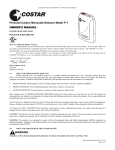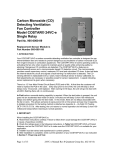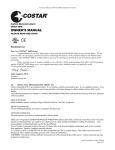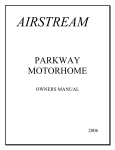Download Costar 9RV Operator`s manual
Transcript
Service Tips WIT Club News – April 2002 CARBON MONOXIDE ALARMS In this article we are presenting excerpts from the operator’s manual for the COSTAR model 9RV carbon monoxide alarms that we are currently using. If the alarm in your vehicle is different, refer to your owner’s information case for information specific to your alarm. Carbon monoxide (CO) is an insidious poison. It is a colorless, odorless and tasteless gas. It is a cumulative poison. Even low levels of CO have been shown to cause brain and other vital organ damage in unborn infants with no effect on the mother. The following symptoms are related to CARBON MONOXIDE POISONING and should be discussed with ALL members of the household: MILD EXPOSURE Slight headache, nausea, vomiting, fatigue (often described as “flu-like” symptoms) MEDIUM EXPOSURE Severe throbbing headache, drowsiness, confusion, fast heart rate EXTREME EXPOSURE Unconsciousness, convulsions, cardiorespiratory failure, death Many cases of reported CARBON MONOXIDE POISONING indicate that while victims are aware they are not well, they become disoriented they are unable to save themselves by either exiting the RV or calling for assistance. Also, young children and household pets may be the first affected. Your CO alarm is designed to detect the toxic CO fumes that result from incomplete combustion, such as those emitted from appliances, furnaces, fireplaces and auto exhaust. WHAT YOU SHOULD DO IF THE ALARM SOUNDS WARNING: Actuation of this device indicates the presence of carbon monoxide (CO) which can kill you. If the alarm sounds: Operate reset/silence button; call your emergency services (fire department or 911); immediately move to fresh air outdoors or by an open door/window. Do a head count to check that all persons are accounted for. Do not reenter the premises nor move away from the open door/window until the emergency services responders have arrived, the premises have aired out, and your alarm remains in its normal condition. After following steps 1-3, if your alarm reactivates within a 24-hour period, repeat steps 1-3 and call a qualified appliance technician to investigate for sources of CO from fuel burning equipment and appliances, and inspect for proper operation of this equipment. If problems are identified during this inspection have the equipment serviced immediately. Note any combustion equipment not inspected by the technician and consult the manufacturer’s instructions or contact the manufacturers directly for more information about CO safety and this equipment. Make sure that motor vehicles are not and have not been operating in an attached garage or adjacent to the residence or RV. IMPORTANT CONSIDERATIONS Manufacturer strongly recommends replacement of the alarm six years after date of purchase. Never disconnect the battery to silence an alarm. The alarm will automatically sense when the level of CO in the air falls below the danger level. You should stay outside the vehicle in fresh air until the alarm is silenced. When the alarm sounds, do not stand too close to the alarm. The sound produced by the alarm is loud because it is designed to awaken a person in an emergency. Prolonged exposure to the alarm at a close distance may be harmful to your hearing. DEVELOPING YOUR OWN CO SAFETY PLAN The CO alarm can quickly alert you to the presence of CO-it cannot prevent toxic CO emissions. Please note that there are hazards against which CO detection may not be effective, such as natural gas leaks or explosions. The ultimate responsibility for protection against toxic CO fumes rests solely on you. Develop a family escape plan and practice it with your entire family, especially small children. - Draw a floor plan of your RV and find two ways to exit. There should be one way to get out of your RV without opening the door. - Teach children what the CO alarm signal means and how they must be prepared to leave the RV by themselves if necessary. - Decide on a meeting place a safe distance from your RV and make sure all children understand where they should go and wait if there is a dangerous CO condition. - Conduct CO safety drills at least every six months to make sure that everyone, even small children, know what to do in order to escape safely. - Know where to go to call the Fire Department from outside your RV. CONDITIONS WHICH CAN RESULT IN TEMPORARY CO SITUATIONS: Excessive spillage or reverse venting of fuel burning appliances caused by outdoor ambient conditions such as: - Wind direction and/or velocity, including high gusts of wind. Heavy air in the vent pipes (cold/humid air with extended periods between cycles). - Negative pressure differential resulting from the use of exhaust fans. - Simultaneous operation of several fuel burning appliances competing for limited air. - Vent pipe connections vibrating loose from clothes dryers, furnaces or water heaters. - Obstructions in or unconventional vent pipe designs which can amplify the above situations. ALARM SIGNALS Normal Operation – RED L.E.D. flashes once every 30 seconds, indicating that the alarm is powered. Alarm Condition – RED L.E.D. turns “on” for two seconds and “off” for three seconds with four short beeps for one second and four seconds of silence. Fault Condition – RED L.E.D. double flash and one beep every 30 seconds. Low Battery – One beep every 30 seconds for a minimum of seven days. Replace the battery when the signal occurs. MAINTENANCE Cleaning your alarm: To clean your alarm, remove it from the mounting bracket. You can clean the interior of your alarm by using your vacuum cleaner hose and vacuuming through the openings around the perimeter of the alarm. The outside can be wiped with a clean towel. Test your alarms weekly and repair or replace them when they no longer function. As with any electronic product, it has a limited life. Alarms that do not work cannot protect you. After cleaning, reinstall your alarm and test your alarm by using the TEST button. WARNING: Do not use any household cleaning agents, paints, varnishes or any other chemical on your 9RV alarm. Note: Regular testing is recommended. BATTERY REPLACEMENT To replace the battery remove the alarm from the mounting plate by rotating the alarm in the direction of the “OFF” arrow on the cover. The COSTAR Model 9RV CO Alarm uses one 9volt alkaline battery. A fresh battery should last for one year under normal operating conditions. USE ONLY THE FOLLOWING 9 VOLT ALKALINE BATTERY FOR CO ALARM REPLACEMENT. Alkaline type: DURACELL MN 1604. WARNING: CHECK THE BATTERY MANUFACTURERS SPECIFICATIONS FOR PROPER OPERATING CONDITIONS. NOTE: Most alkaline batteries are not rated below –35 degrees C or above 52 degrees C. WARNING: USE ONLY THE BATTERY SPECIFIED. USE OF DIFFERENT BATTERIES MAY HAVE A DETRIMENTAL EFFECT ON THE CO ALARM. THE CONSTANT EXPOSURE TO HIGH OR LOW TEMPERATURS OR HIGH HUMIDITY MAY REDUCE BATTERY LIFE. PERIODIC ALARM TESTING Test alarm weekly for proper operation by pushing the test button until a short beep is heard (approximately three seconds). Release the button. The alarm will then test itself for proper operation and the RED L.E.D. light will flash 4-5 times. At completion of the self-test, the alarm will sound two patterns. The alarm then resumes normal operation. WARNING: TEST ALARM OPERATION AFTER RV HAS BEEN IN STORAGE, BEFORE EACH TRIP AND AT LEAST ONCE PER WEEK DURING USE. SERVICE AND WARRANTY If you feel that your CO alarm is defective in any way, do not tamper with the unit. Contact Quantum Group’s customer service: Quantum Group Inc. 11211 Sorrento Valley Road, Suite A San Diego, CA 92121-1323 800/423-5599 [email protected]











